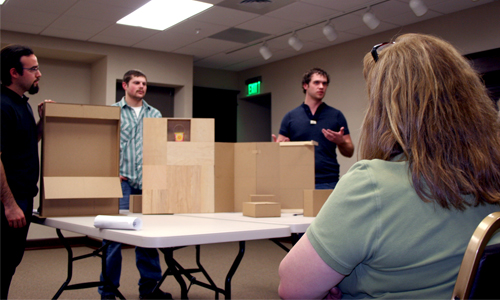Community Design Center:
What is Community Design Center?
The Community Design Center was an excellent opportunity for students to get a taste of professional work. As a group of three, my colleagues and I were charged with the task of assisting the Big Horn County Museum in Hardin, Montana with developing a display for their opening exhibit space within their new building. Our first idea was to merely set up a one off display using our knowledge of spacial arrangement by researching their artifacts. We developed a photographer thread concept after becoming aware of their extensive collection of amazing photographs. This soon lead to another concept, which was a modular display system that would allow a small town museum to quickly and effectively change their exhibits at low cost, while allowing great variation. Each of the three team members developed their own modular system. My own is displayed here. However that wasn’t the end of our work there. We had several meetings with members of the city and city council for feedback as we developed not only our systems, but also developed more ideas. We also met frequently with David Swingle of the Museum of the Rockies, who was very informative and very fond of what we were developing. At the end of our project, we implemented QR codes for interactivity and new way of looking at museum spaces. We also developed ways of helping visitors navigate the space and correlated all the work we had done into their exterior displays as well. We were given the opportunity to give our final presentation, which was in the form of a slide show, again at other museum related events.
The Design
Design Statement: Design Statement: The module system that I had developed in this study is complex in its simplicity. The system isn’t a visual design statement; its humble nature allows its intent to be truly in line with filling the museums needs, and by doing so strengthening the museum. One aim was to keep this system as simple as possible, and hence keeping it incredibly easy to use. To keep the system simple, it uses only five panel sizes. These panels are interchangeable in an unaltered state within this module study and as well as module study two, which are systems independently developed. The fastening system should be incredibly easy to use, ideally being a hand fastening system not requiring tools. Once the modules are assembled, they should be able to attach to one another at regular intervals, allowing offsetting of the modules and in doing this, increasing the flexibility of the system. The panels are of a fixed dimension and simplistic, this allows other materials to be cut and substituted into the system which again increases the flexibility of the system. One such substitution could be salvaged wood. Not only would the aged wood find a renewed use but the effect of old wood to the human perception would allow certain artifacts to be presented in more context to the item; setting a certain mood. The overall goal of this system is to be as flexible as possible within a fixed system because the flexibility makes the system adaptable, while making it work within a rigid system, makeing it easier to comprehend and utilize.
























